Behind the 60 billion USDC: Revealing the Rise of the Circle Empire

Reprinted from panewslab
04/20/2025·1MAuthor: Tanay Ved
Compilation: Vernacular Blockchain
Key points:
1. Circle achieved revenue of US$1.7 billion in 2024, of which 99% came from interest income from USDC reserves. The total allocation costs with partners such as Coinbase and BN totaled US$1.01 billion, reflecting the key role of the trading platform in expanding USDC coverage.
2. Total USDC supply has rebounded to US$60 billion, with an average 30-day transfer volume reaching US$40 billion, showing market confidence and recovery of cross-chain adoption. However, USDC remains sensitive to interest rate changes, competitive pressures and regulatory developments.
3. USDC's use of major trading platforms continues to grow, currently accounting for 29% of BN's spot trading volume, thanks to Circle's strategic partnership.
4. Looking ahead, the next phase of Circle may rely on diversification from passive interest income to active income sources, including tokenized assets, payment infrastructure and capital market integration.
introduction
Circle, the largest stablecoin issuer in the United States and the company behind the $60 billion USDC, recently submitted an IPO application, providing an opportunity to see the financial status and strategic prospects of the cryptocurrency-based company. As the only way in the open market to directly invest in the fastest growing area of cryptocurrencies, Circle’s IPO application is at a critical moment when stablecoin legislation is gradually taking shape and competition is intensifying. Although market conditions may lead to IPO delays, combined with USDC’s on-chain data, we will extract key information from Circle’s IPO files, analyze its revenue sources, the impact of interest rates on its business, and the role of platforms such as Coinbase and BN in shaping USDC distribution, and evaluate Circle’s positioning in an increasingly competitive market.
Circle Financial Overview
From its initial Bitcoin payment application to becoming a leading stablecoin issuer and crypto infrastructure provider, Circle has faced many challenges over its 12-year journey. After explosive revenue growth in 2021 (450%) and 2022 (808%), growth slowed down in 2023 with revenue growth of 88%, when USDC was affected by the bankruptcy of Silicon Valley. At the end of 2024, Circle reported revenue of US$1.7 billion, a year-on-year increase of 15%, showing a more stable expansion trend.
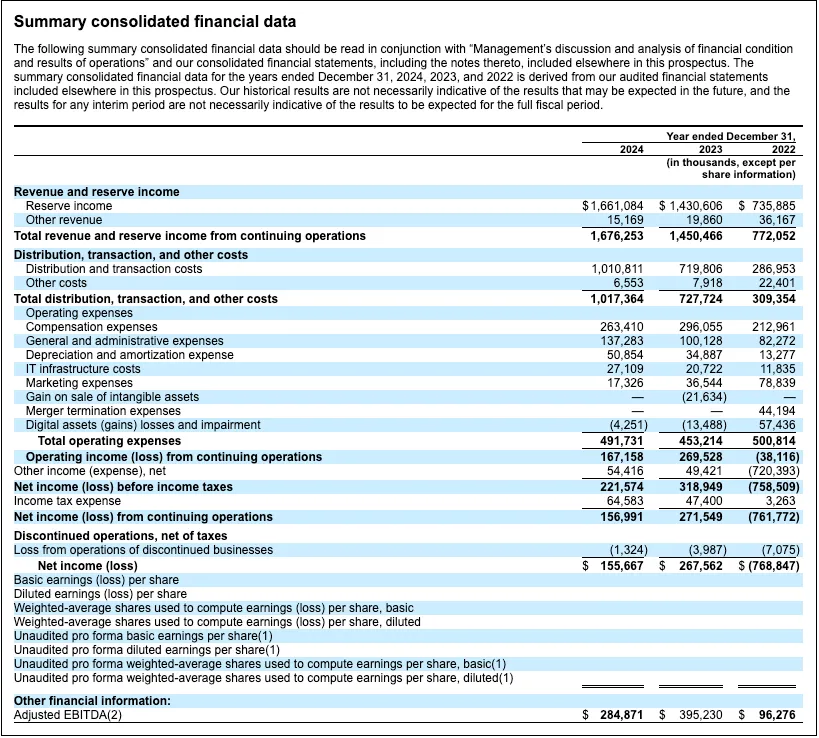
Source: Circle S-1 File
However, profitability compressed, net profit and adjusted EBITDA fell 42% and 28% to $157 million and $285 million, respectively. It is worth noting that Circle's financial data shows that revenue is highly concentrated on reserve interest income, with the allocation costs of as much as about $1.01 billion with partners such as Coinbase and BN. But these factors have driven a recovery in USDC supply, up 80% year-on-year to $44 billion.
On-chain growth of USDC
USDC is the core of Circle's business and was launched in 2018 in partnership with Coinbase. USDC is a tokenized form of USD, allowing users to store value in digital form and trade on the blockchain network, achieving near-instant low-cost settlement. USDC adopts a full reserve model, backed 1:1 by high liquidity assets, including short-term U.S. Treasury bonds, overnight repurchase agreements and cash held by regulated financial institutions.
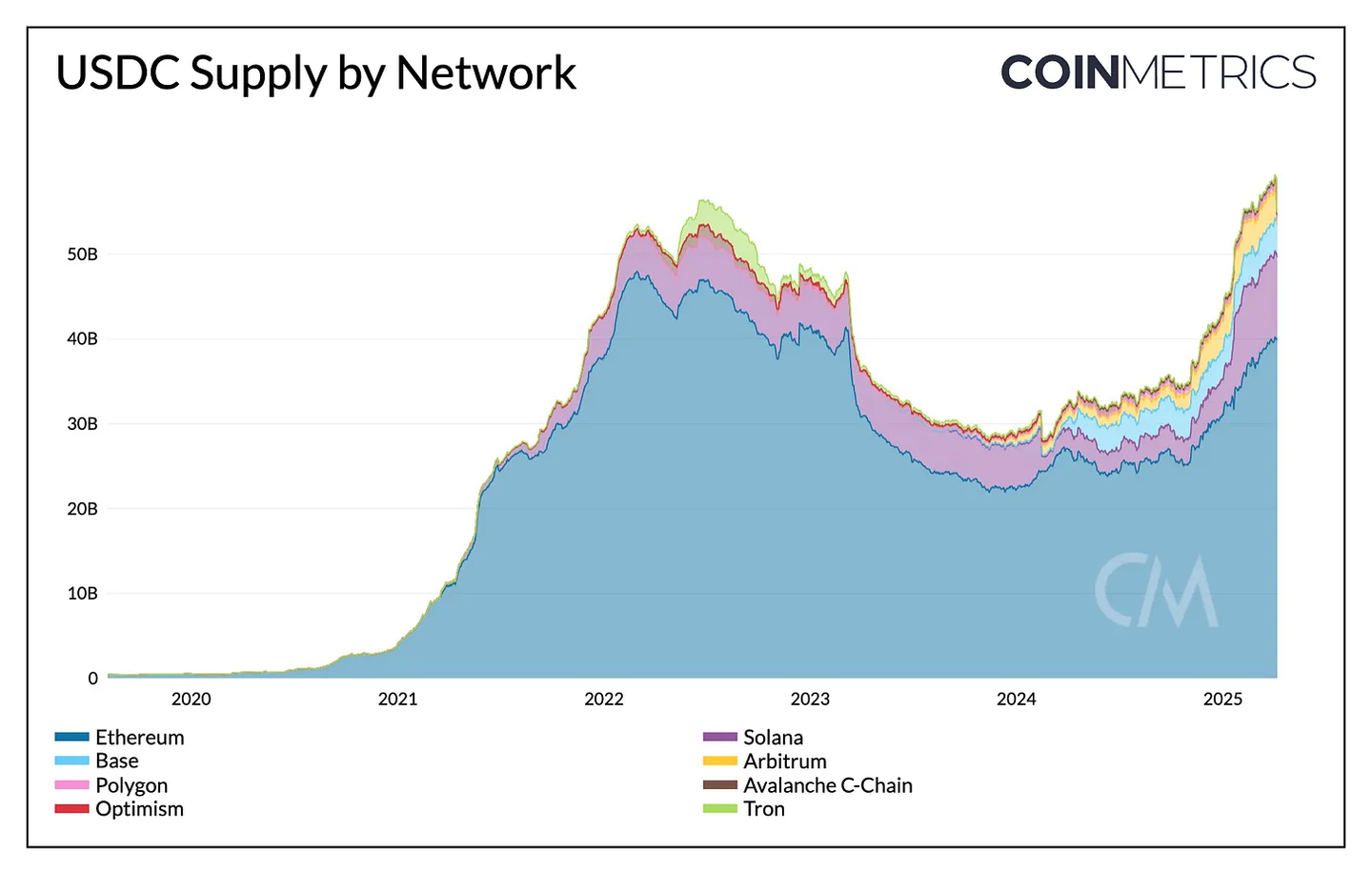
Source: Coin Metrics Network Data Pro & Coin Metrics Labs
The total supply of USDC has grown to about US$60 billion, firmly ranking second largest stablecoin after Tether's USDT. Despite pressure on market share in 2023, it has rebounded to 26%, reflecting the recovery of market confidence. Of these, about US$40 billion (65%) were issued on Ethereum, US$9.5 billion was on Solana (15%), US$3.75 billion was on Base Layer-2 (6%), and the rest were distributed on chains such as Arbitrum, Optimism, Polygon, and Avalanche.
USDC's speed and transfer volume also increased significantly, with an average 30-day transfer volume reaching approximately US$40 billion. In 2025, USDC transfers mainly occurred on Base and Ethereum, and sometimes accounted for 90% of the total adjusted transfers.
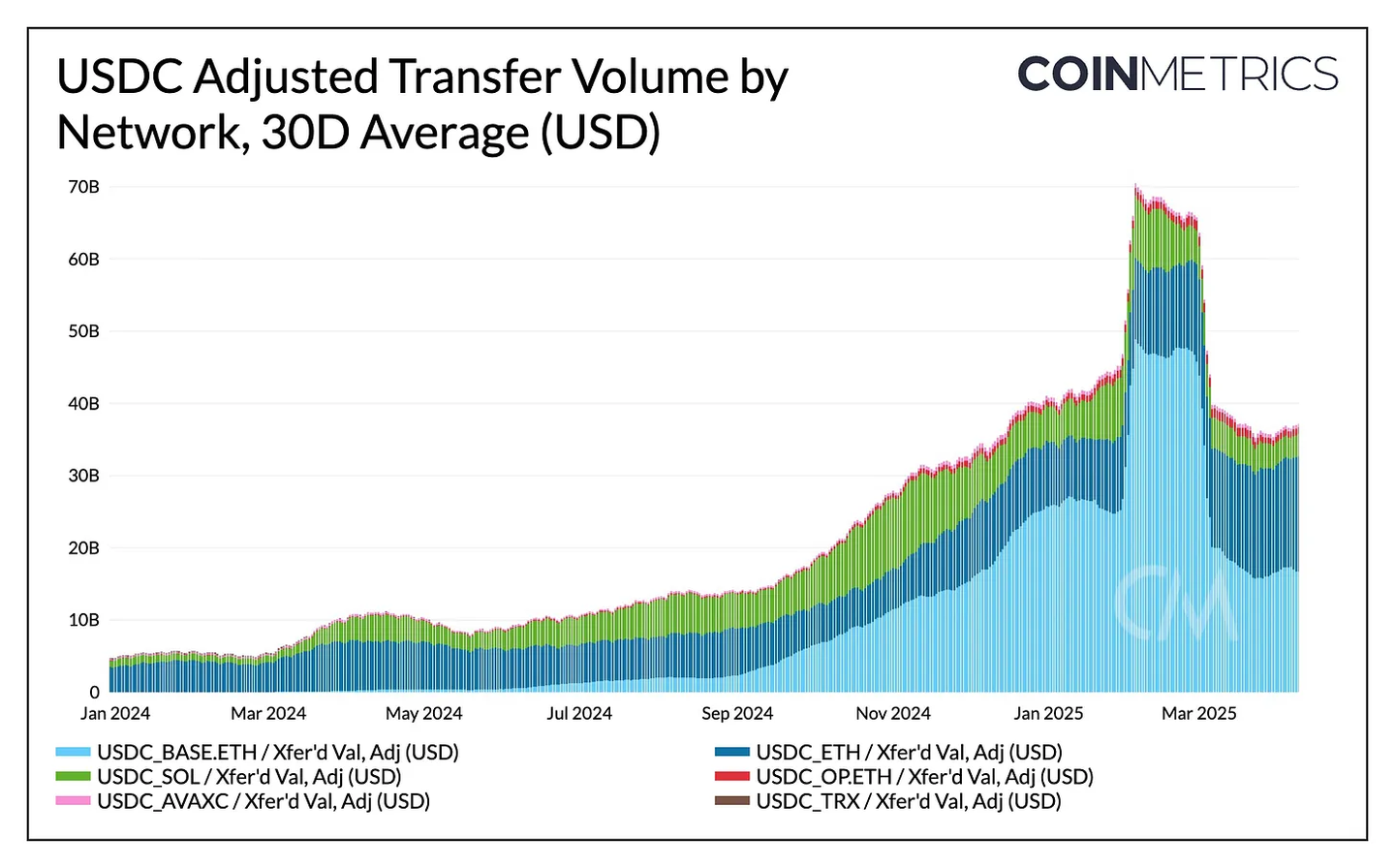
Source: Coin Metrics Network Data Pro
These indicators show that USDC usage continues to grow as stablecoins become more attractive as USD alternatives in emerging markets and payments and fintech infrastructure. This also reflects Circle's cross-chain strategy, which is widely available on major blockchains and is supported through interoperability tools such as Cross-chain Transfer Protocol (CCTP).
Reserve composition and interest rate sensitivity
For every dollar USDC issued, Circle will reserve investment in a portfolio of high-liquid, low-risk assets such as short-term U.S. Treasury bonds and cash deposits. This structure allows Circle to earn benefits from reserves while ensuring USDC holders liquidity and redemption stability. Circle disclosed in the filing that reserve revenue in 2024 was $1.6 billion, or 99% of total revenue, indicating that its revenue structure is highly dependent on interest rates.
USDC Reserves are primarily held in the Circle Reserve Fund, a SEC registered government money market fund managed by BlackRock. According to Circle's monthly certification, financial statements and the BlackRock Circle Reserve Fund, as of April 11, US$53.5 billion (about 88%) of USDC reserves consisted of U.S. Treasury bonds and overnight buyback agreements with several financial institutions, all with a term of less than 2 months. In addition, 11% of the reserves are cash deposited in regulated banks.
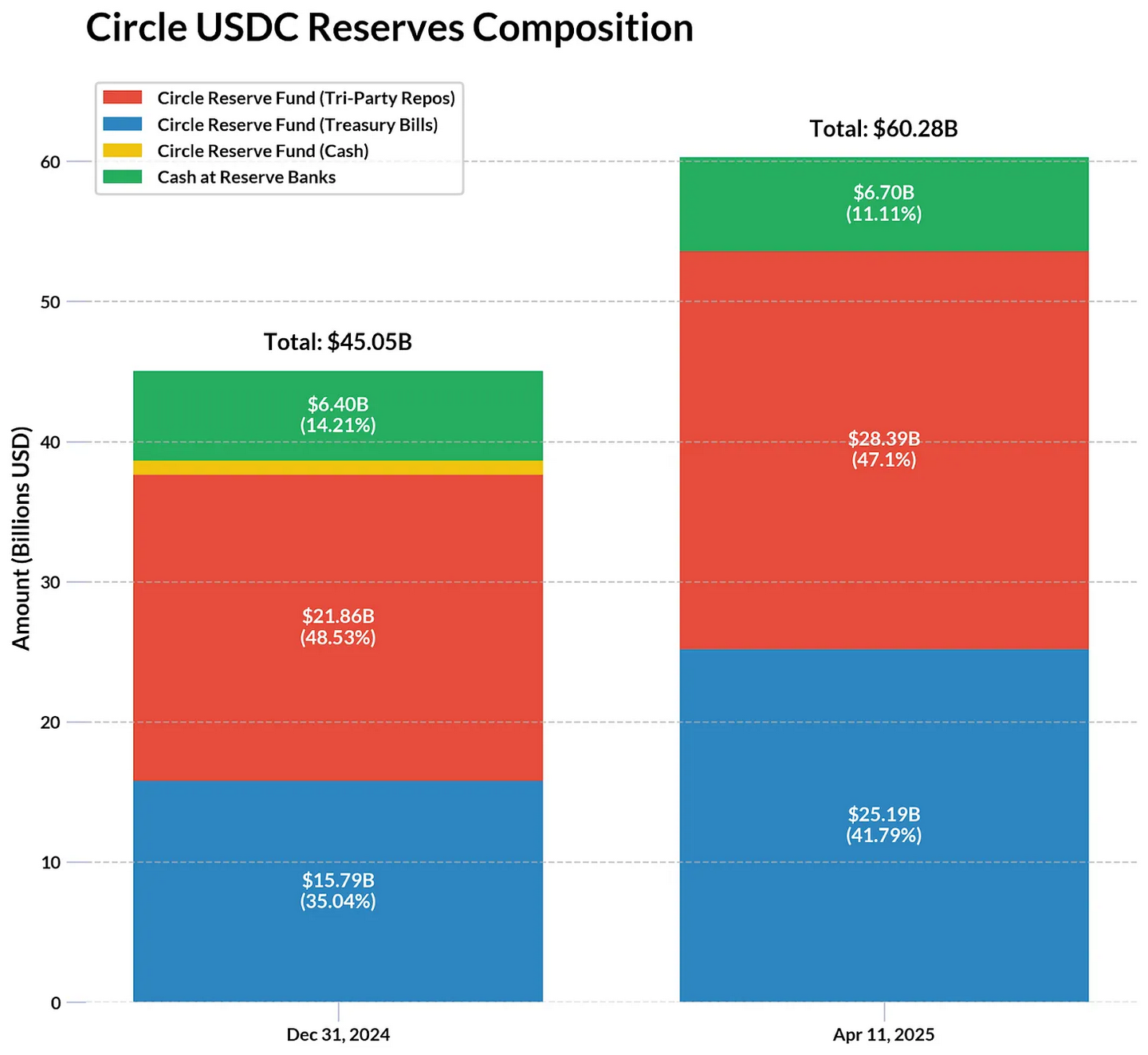
Source: Circle Transparency & BlackRock Circle Reserve Fund
Based on Circle's 2024 reserve revenue of US$1.6 billion and approximately US$44 billion in reserve assets, the estimated annualized rate of return is about 3.6%. Circle's reserve revenue may remain stable if interest rates remain current and USDC supply remains stable or grow.
Our previous study on the decline in USDC supply during periods of rising interest rates showed that Circle's reserve income is highly correlated with current interest rates, indicating the sensitivity of its income model to interest rate changes. The effective federal funds rate for 2024 is between 4.58-5.33%, what is the outlook for Circle if the interest rate drops? In the S-1 file, Circle estimates that a 1% drop in interest rates could result in a $441 million decrease in stablecoin reserve revenue, a key risk outlined in the file.
As Circle retains all earnings (unlike issuers such as Ethena and Maker pass interest on holders), its business model remains sensitive to future interest rate changes, competitive pressures and regulatory evolution.
Distribution, distribution, distribution
Coinbase and BN roles
Circle's IPO filing also reveals the importance of partners such as Coinbase and BN in promoting USDC adoption. In 2024, its distribution costs totaled US$1.01 billion, a 40% increase from 2023 and 150% increase from 2022.
Although Coinbase’s relationship with Circle is well known, the documents show that the two are more financially connected. In 2024, Coinbase earned $908 million from USDC-related activities, accounting for approximately 13.8% of its total revenue. Under the revenue sharing agreement with Circle, Coinbase receives 100% interest on USDC held on its platform, and 50% interest on USDC held elsewhere. As USDC supply on the Coinbase platform increases from 5% to 20% in 2022, most of the economic gains appear to be attributable to Coinbase. The document also disclosed a one-time payment of $60.25 million to BN to facilitate distribution in a similar way.
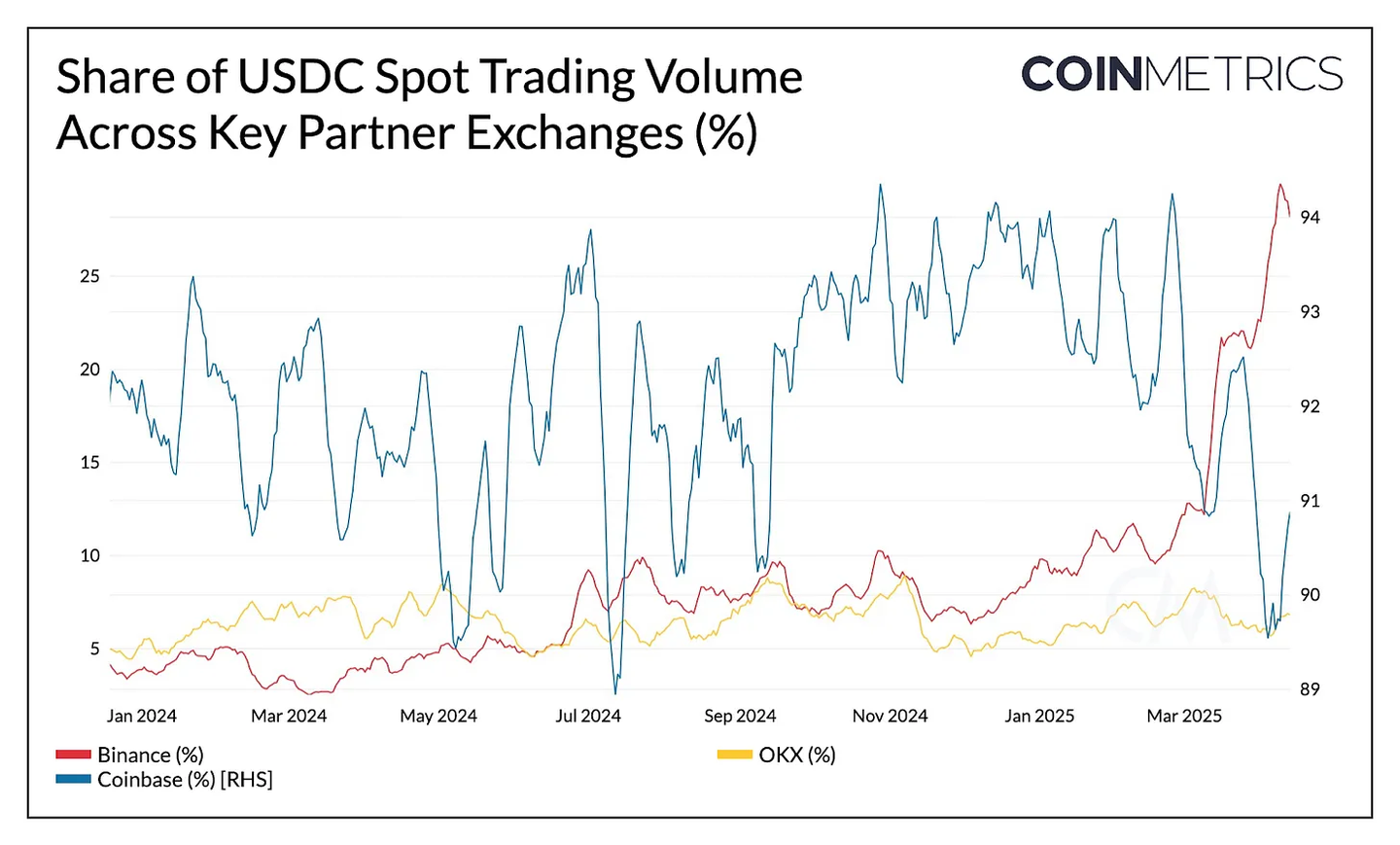
Source: Coin Metrics Market Data Feed
Observing spot trading activities of key partner trading platforms, USDC now accounts for 29% of BN spot trading volume (about US$6.2 billion), surpassing its share after FDUSD's recent decoupling, second only to USDT, which accounts for about 50%. On Coinbase, USDC drives approximately 90% of spot trading in the combined USD and USDC markets.
Despite the high costs, Circle's distribution efforts have translated into significant adoption at the trading platform level, driving USDC's liquidity and $10 billion trusted spot trading volume across trading platforms.
Beyond the trading platform: empowering DeFi and business
By distinguishing the USDC provisions held on Ethereum with externally owned accounts (EOAs), you can understand how USDC is distributed in user wallets and applications. Currently, approximately US$30 billion is held by EOA, up 66% year-on-year, while approximately US$10 billion in smart contracts is up about 42% year-on-year. The growth in EOA balances may reflect the increase in trading platform custody and individual user holdings, while the growth in smart contracts demonstrates the importance of USDC as collateral and liquidity in the DeFi lending market.
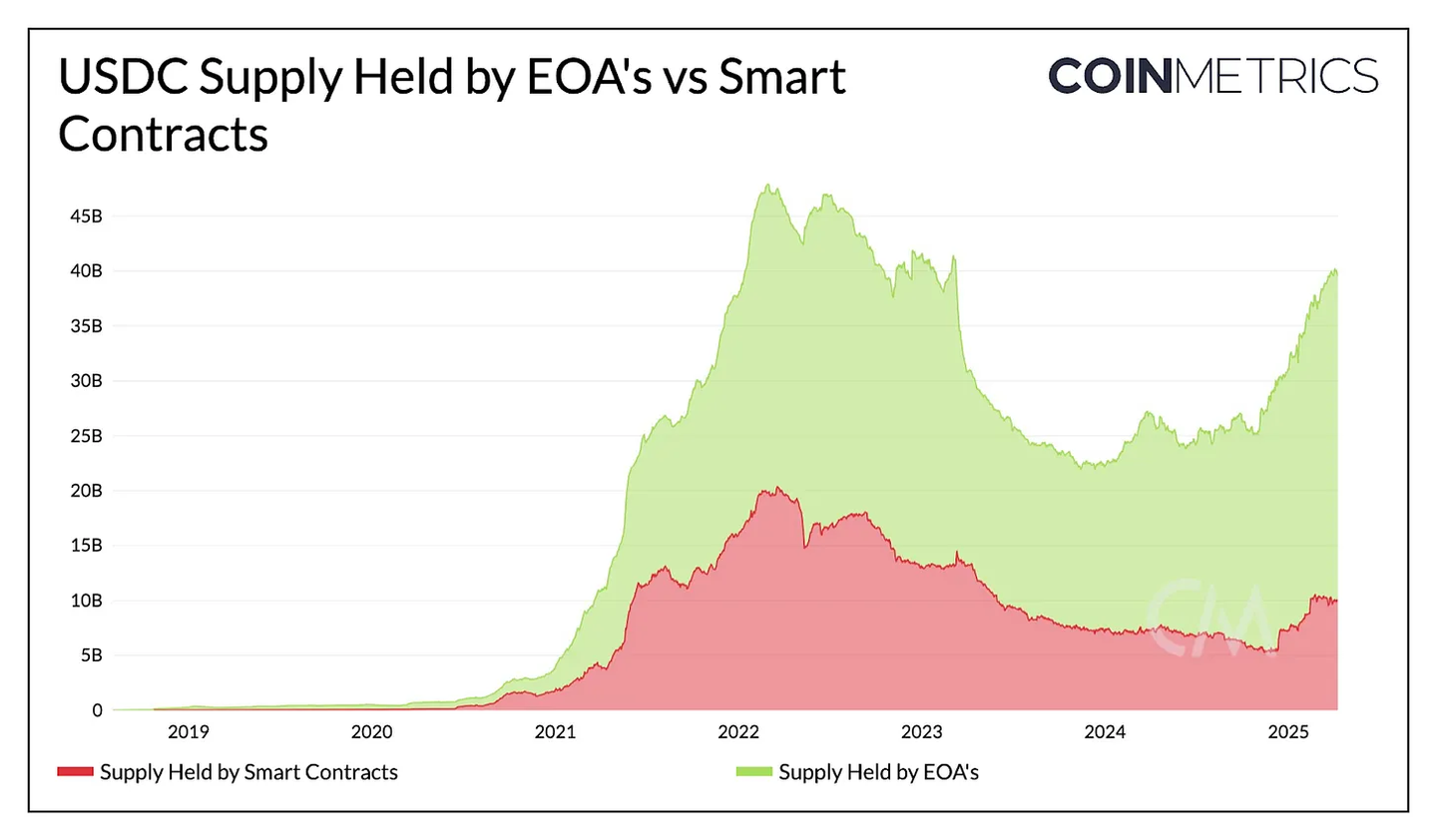
Source: Coin Metrics Network Data Pro
USDC continues to play a fundamental role in the DeFi lending market, with agreements such as Aave, Spark and Morpho locking in over $5 billion (representing the unlent USDC supply portion). For mortgage debt agreements such as Maker (now Sky), approximately US$4 billion of USDC supports the issuance of Dai/USDS through its peg stabilization module.
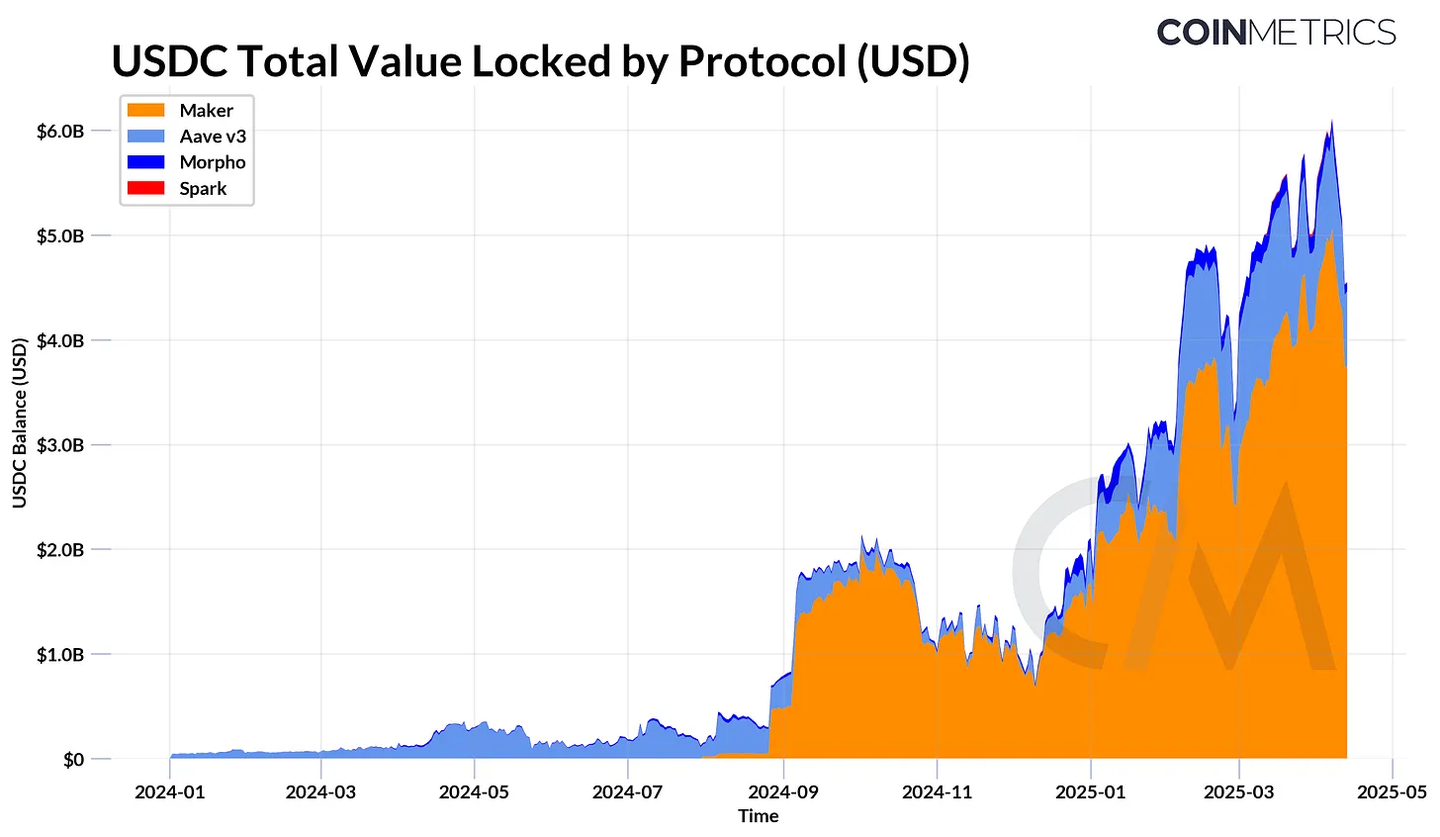
Source: Coin Metrics ATLAS & Reference Rates
Similarly, USDC is a key source of liquidity for various DEX pools, facilitating stable value trading. It also increasingly supports the on-chain forex market, especially with the rise of other fiat-linked stablecoins such as Circle's MiCA-compliant stablecoin EURC.
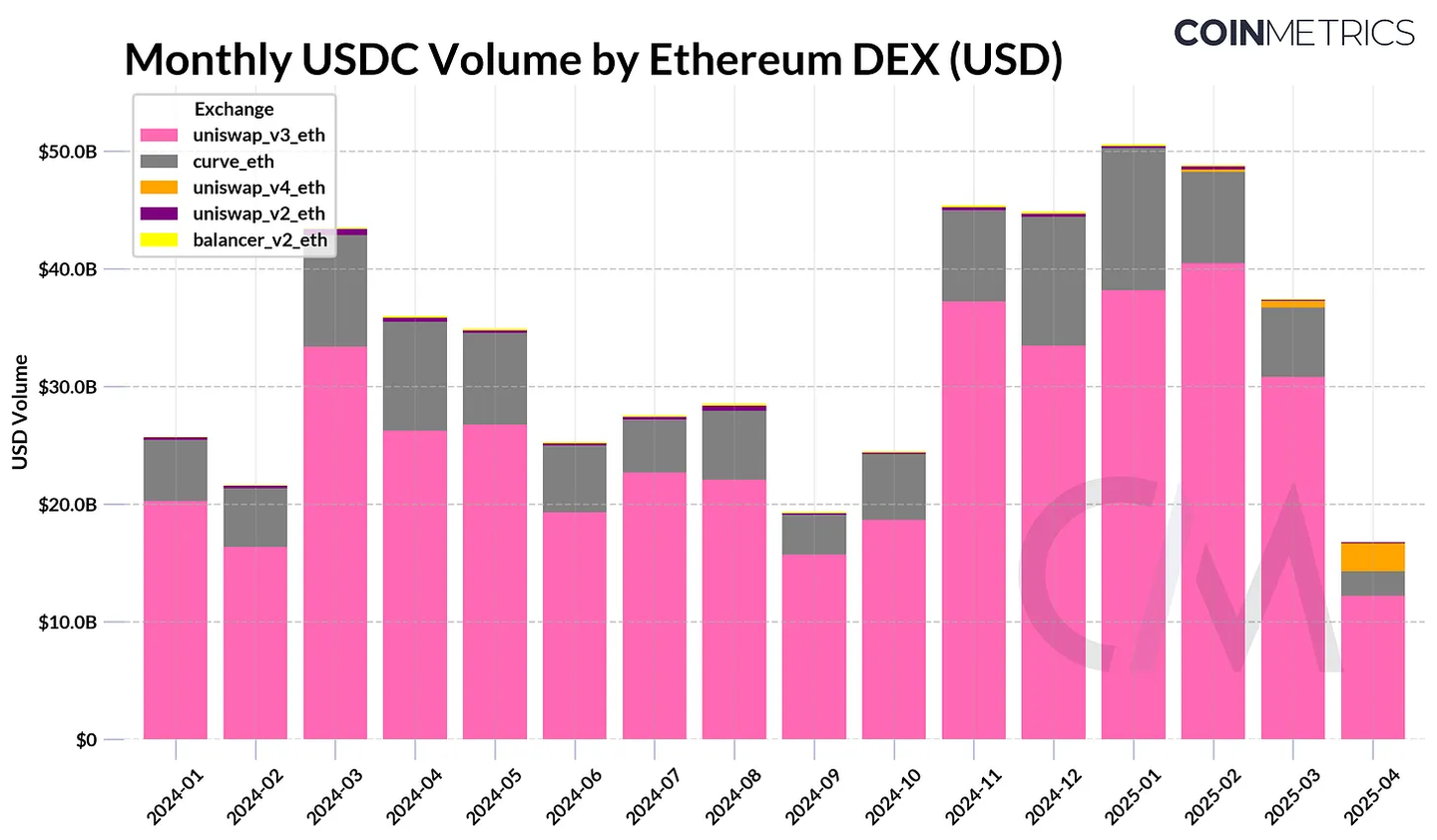
Source: Coin Metrics DEX Data
in conclusion
USDC’s on-chain growth reflects a recovery in market confidence, but Circle’s documentation also highlights key challenges, especially high distribution costs and heavy reliance on interest income. To maintain momentum in a low-interest rate environment, Circle aims to diversify revenue through active product lines such as Circle Mint and expand its tokenized asset infrastructure through the acquisition of Hashnote, the largest issuer of Tokenized Money Market Fund.
Circle is in a good position as regulatory clarity increases, especially the SEC's position that stablecoins are not securities. But it now faces growing competition from overseas publishers such as Tether and a new wave of U.S. competitors taking advantage of the momentum of policy changes. Although Circle's valuation has not been determined, its IPO will mark the first opportunity for the open market to invest directly in stablecoin infrastructure growth.

